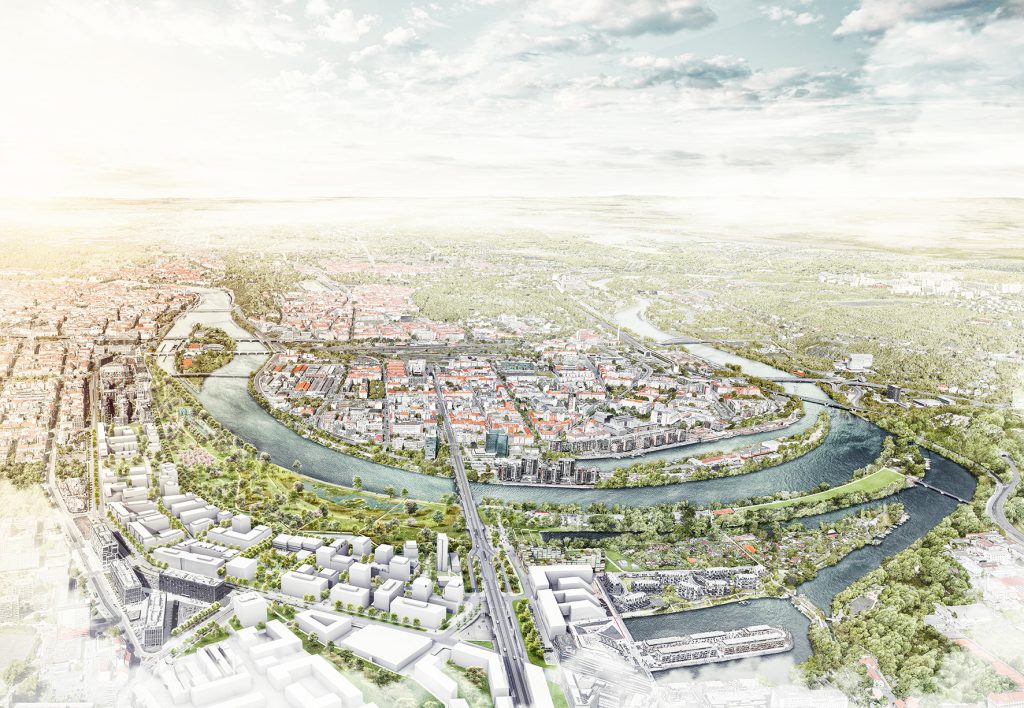
The success of future cities depends on the extent to which existing professions, more precisely the professionals who work in them, are able to transcend the boundaries of their disciplines and mind-sets.
Billboard
Skyscrapper
Halfpage
What makes urban space accessible? What are the keys to guaranteeing that residents and outside visitors alike will take ownership of it and use it? How can green infrastructure foster maximum openness of the public realm? And finally: what can technical innovations contribute to transform cities into truly integrative places? The forum “Connective Spaces”, hosted by Topos, the German architecture magazine Baumeister and lighting specialist Schréder, investigated these crucial questions, sparking lively debates between four participants from very different backgrounds: landscape architect Leonard Grosch, architect Jan Liesegang, academic expert Undine Giseke and Schréder top manager Ernst Smolka. One conclusion, however, they all agreed on: the success of future cities depends on the extent to which existing professions, more precisely the professionals who work in them, are able to transcend the boundaries of their disciplines and mind-sets.
The forum, which took place during this year’s Metropolitan Solutions conference, held in Berlin, is part of the “Baumeister Topos Cities Initiative”: it was launched in 2015 and examines a wide range of aspects of urban design, and urban planning and development, through events and publications. In 2016, connectivity is in the centre of the initiative’s attention. When it comes to connective spaces and interconnecting people, one may first of all think of technical infrastructure. Dr. Ernst Smolka, general manager of Schréder GmbH, pointed out how new modular technologies such as Schréder’s “Shuffle” can spark a shift in the way lighting solutions are perceived in urban contexts: the lumière no longer functions just as a tool for illuminating a space. Instead, it becomes a complex interactive instrument that integrates a variety of highly different functions, which fulfil the kinds of demands that today’s citizens will increasingly make on public spaces and their infrastructure. Accessibility to public wifi, provision of electricity and availability as a security device are just three examples. It comes as no surprise then that great attention is being paid to the lumières of the future and whether they are able to provide the resources and services that are required of them by urban dwellers.
In fact, infrastructure is just one angle from which to view the concept of connectivity. Leonard Grosch, partner at Atelier Loidl Landscape Architecture, Berlin, explained how modern metropolitan parks such as Atelier Loidl’s Park am Gleisdreieck in Berlin seek to bring together people from many different cultures and backgrounds in a subtly modern and contemporary way – and how that central goal influences a designer during their planning. He stressed the fact that the elaborate participatory process that preceded and accompanied the planning phase for Gleisdreieck enabled the landscape architects to better understand what this space that was to become a park actually meant to people. Even if discussions easily frayed into detail issues and even if many of the participants clang to the romantic railway scenarios that once characterized the Gleisdreieck area, Grosch insisted that the participation of citizens and other stakeholders will significantly inform a place’s design for the better. For in the course of this process, designers and landscape architects are required to balance the demands of the public, the aesthetic qualities of the space, and its potential in terms of urban connections and surroundings.
Jan Liesegang, architect at Raumlabor Berlin, would surely agree here. Together with Undine Giseke, Professor for Landscape Architecture and Open Space Planning at TU Berlin, he debated the question of when exactly participation should come into the planning process. They both emphasized that an early starting point facilitates mutual understanding and trust between designers and future users. Asked whether citizens nowadays are ready to actively support and influence spatial change processes, Giseke and Liesegang came to the same conclusion: citizens are more willing to participate than ever before. In fact, Liesegang and Giseke believe that architects and landscape architects should work together as closely as possible and alongside manufacturers and construction companies that develop connective solutions. Not only in order to find adequate products for such solutions but also to gauge their effects on urban culture in both the short and the long term. Liesegang, Giseke, Grosch and Smolka share the conviction that the more professionals suspend the divides that separate their professional fields and instead clear the way for new combinations of expertise and creativity, the more integrative the future city will become. And the more people will benefit from this evolution.
Medium Rectangle
Halfpage













